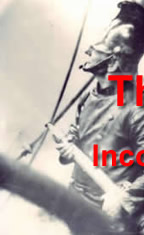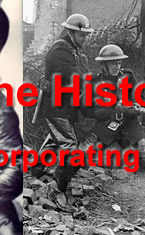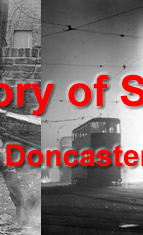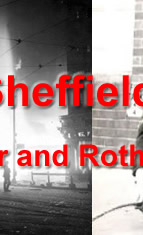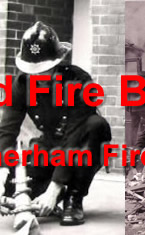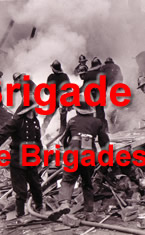
Water for fire fighting in the early days was provided in a most unusual way. Records show that a William Barker lived in Balm Green in 1379. In 1434 steps were taken to make some sort of reservoir for storing water from the many springs running down from the hills surrounding Balm Green. This reservoir was situated on approximately the same site as the City Hall at the top of Balm Green and became known as Barker's Pool. In 1572 Robert Rollynson who appeared to be a public benefactor, made extensive alterations to this "Pool" by erecting a wall around it, and providing sluice gates. When these were opened water was allowed to run down channels in the middle of the streets. The water could he used to cleanse the streets as well as for fire fighting in conjunction with the leather buckets.



 |
In the Bursary Accounts for 1620 there is an entry which states "To Thomas Wheelwright for dressing buckets 1/6d" proving that someone attended to these items. The 1/6d appears to be an annual fee because it was paid for a number of years.
The earlier types of fire bucket were made solely of leather and were sewn with leather thongs. The seams were "caulked" with pitch and the dressing done by Thomas Wheelwright meant that an inspection of the seams and the application of pitch were necessary. In 1697, 2/6d was paid to Nathaniel Mearls for "Kitts" (small buckets) when the bakehouse was on fire.
The earliest known example of a fire pump was used by the Greeks in 300 B.C. The use of this device was lost in the Middle Ages and was not recovered until the 16th century. The earliest pump to be used on fires in this country was in the form of a squirt. It was designed to direct a jet of water onto a fire, and was constructed in the form of a syringe, the body being held by two men whilst the third forced home the plunger.
However, it was not until the Great Fire of London in 1666 that the necessity for more efficient fire fighting apparatus was realised in this country and in 1667 the establishment of Insurance Fire Brigades brought about a greatly increased development of manual pumps which required relays of men to keep their tank full of water.
Until the beginning of the 18th Century, Sheffield had no firefighting equipment except a few "leathern buckets” which were hung in the Chancel of the Church and in the Town Hall.
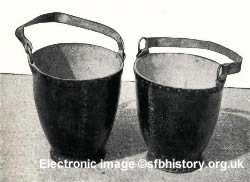 |
“Leather Buckets”- kept in the Church and Town Hall for fire-fighting purposes. |





 |
In the year 1703 the Town Trustees purchased their first fire engine and organised men to operate it. It was housed in an old building on the north side of the Chancel of the Parish Church, and was occasionally taken out for a practice at the cost of one shilling with another shilling for filling the engine with water when "played".
 Photograph: 'Sheffield Fire Brigade - A Brief History' A hand drawn, manually operated fire engine, provided by Messrs. J. T. and W. Wilson., for use in their Snuff Mills. The base contained water, kept filled by bucket chain, and the two transverse poles were operated up and down by volunteers. Two pistons inside the upright box were thus made to pump water through leather hose connected to the coupling at the front |
According to the Burgery Accounts for 1704 the sum of' 10s 0d was paid to one William Frost, being his annual wage for cleaning and maintaining the fire engine. The payment was made again in the following year but it was stated that this would be the last time it would be made,
For nearly 40 years little is recorded about the activities of the fire engine. Either Sheffield was very lucky or the fires that did occur were not serious enough to be mentioned in official reports: but it must be kept in mind that the population of Sheffield at this time was less than 10,000.
In 1759 repairs were carried out to the Fire Engine and equipment by one Aeran Loton at a cost of £21 14s 7d. In 1760 one shilling was paid for the leveling of the causeway in front of the engine house. In 1784 the Town decided that a new fire engine was needed and one was purchased from Messrs. Hadley & Sons at the cost of £45 17s 0d plus 4s 0d carriage from Tinsley.
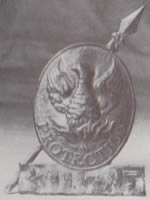 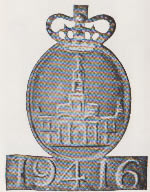 |
| The first Fire insurance was taken out in Sheffield in 1790 and in 1800 the Royal Exchange and the Phoenix Fire Insurance Companies paid £20 and £21 respectively to the Town Council towards the upkeep of the Fire Brigade. |
In 1804 the Town Council paid £15 15s 0d to the Water Company for the use of water and fire plugs for one year. Perhaps because of increasing costs the Town Council, on the 14th February, 1805 said that in future the Town Trustees would not pay for the expense of the fire engine attending fires, but that the persons on whose property the fire occurred would be liable for the charge. Indeed, a Mr. John Furniss was asked to pay 30s 0d for the attendance of the engines and firemen at his premises when on fire. Following this rather drastic measure it was then resolved that the Insurance Companies should be asked to take over part of the responsibility by making an allowance towards the upkeep of the service and payment of the Firemen's Wages.
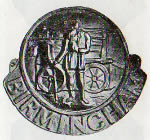 |
| On the 27th February, 1807 the Town's Fire Engines were presented to the Directors of the Birmingham Fire Office who undertook to keep them in repair and employ men to work them. |
